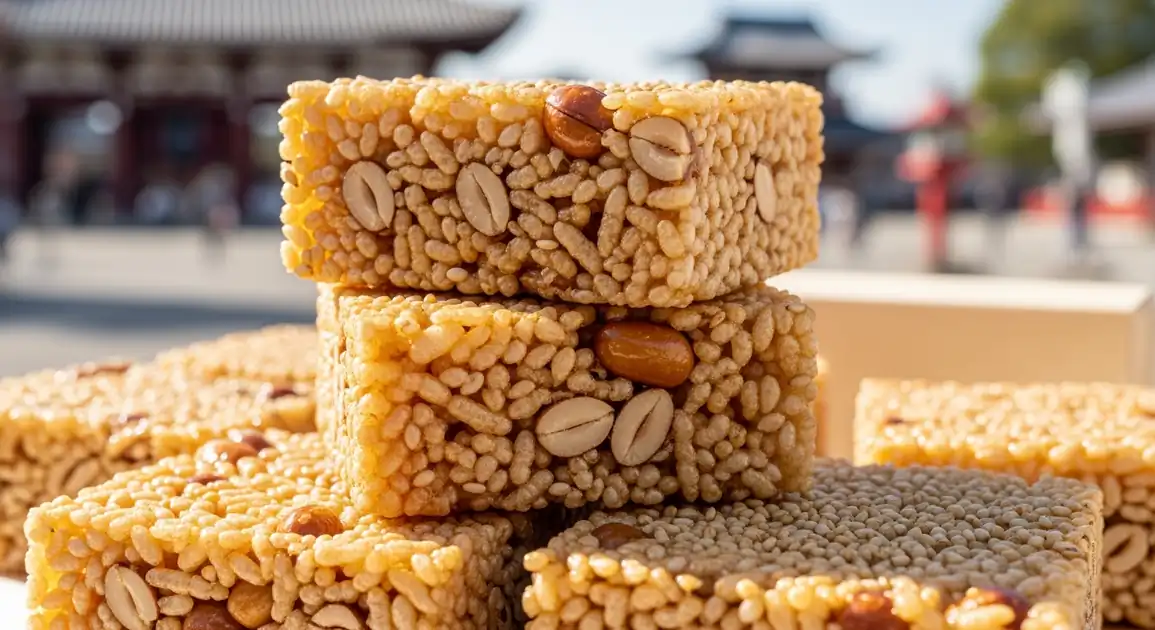Kaminari Okoshi (Puffed Rice Cracker)
雷おこし

Description
Kaminari Okoshi is renowned throughout Japan primarily as a signature souvenir ('omiyage') from Tokyo, specifically the Asakusa district. While its heartland is Tokyo, you can readily find packaged Kaminari Okoshi in souvenir shops at major airports (Narita, Haneda), key train stations (like Tokyo Station), and in the food basements ('depachika') of department stores across the country.
Dietary Information
Serving information
Serving style
Sold pre-packaged in sealed plastic bags or cardboard boxes. Inside, the okoshi may be cut into small blocks or squares, often individually wrapped for freshness and convenience. Eaten directly from the packaging as a snack.
Quick facts
Safety Tips
What to Look For
-
Unexpired, clearly marked 'Best Before' date ('賞味期限' - shōmi kigen)
This date indicates how long the snack will retain its optimal quality, primarily crispness. Always choose packages well within their date for the best experience.
-
Intact, well-sealed packaging (bag or box)
Proper sealing protects the Kaminari Okoshi from air and moisture, which are the main enemies of its crisp texture. Avoid packages that are torn, punctured, or seem loose.
-
Reputable vendors or established brands (e.g., Tokiwado)
Well-known shops, especially those in Asakusa specializing in okoshi, or recognized brands found in department stores, generally adhere to higher quality control standards for ingredients and freshness.
-
Clear ingredient list ('原材料名' - genzairyōmei) if checking allergens
Essential for anyone with allergies to peanuts, sesame, soy, wheat, or gluten. Japanese packaging law requires clear allergen labelling.
What to avoid
-
Packages significantly past the 'Best Before' date
The snack will likely be stale, potentially soft or chewy instead of crispy, and may have an off-flavor. It's generally safe but unpleasant to eat.
-
Damaged, torn, crushed, or poorly sealed packaging
Indicates potential exposure to air and moisture, leading to staleness, or possible contamination. Crushed pieces also detract from the experience.
-
Snacks displayed in direct, prolonged sunlight or overly humid conditions
Heat and humidity can degrade the quality and crispness even before the expiration date, and potentially affect the syrup binder.
-
Unlabelled or dubious homemade versions if ingredient certainty is needed
While potentially charming, unlabelled snacks lack crucial date and ingredient information necessary for ensuring freshness and managing dietary restrictions/allergies.
Price information
Price range
Budget tips
- Small bags or basic boxes typically cost between 500 and 800 JPY.
- Larger, decorative gift boxes or flavor assortments usually range from 1000 to 3000 JPY or more.
- Buying directly from specialty shops in Asakusa might offer slightly better value or unique varieties compared to airport prices.
- Look for multi-buy offers if purchasing several gifts.
Value indicators
- Freshness indicated by a distant 'Best Before' date.
- Noticeably crisp texture (though hard to judge before opening).
- Generous and visible amount of peanuts and/or sesame seeds.
- Purchase from a well-regarded brand or historic shop.
- Packaging is attractive and well-sealed.
Where to Find This Dish
Asakusa (Tokyo)
The definitive place to buy Kaminari Okoshi, especially along Nakamise-dori.
Senso-ji Temple, Kaminarimon Gate, Nakamise-dori Shopping Street
Daytime (approx. 9 AM - 6 PM)
Airport Souvenir Shops
Conveniently located in departure areas of international and major domestic airports.
Narita Airport (NRT), Haneda Airport (HND)
Airport operating hours
Major Train Station Souvenir Areas
Shops within large stations often stock famous regional souvenirs.
Tokyo Station (e.g., Gransta), Shinjuku Station
Station shop hours (often 8 AM - 10 PM)
Department Store Food Halls ('Depachika')
Basement food levels of major department stores carry high-quality confectionery.
Mitsukoshi, Takashimaya, Isetan, Daimaru
Department store hours (typically 10 AM - 8 PM)
Vendor Tips
- Look for shops specializing in 'okoshi' or traditional Japanese sweets ('wagashi').
- Always check the 'Best Before' ('賞味期限') date before purchasing.
- Consider assortment boxes ('tsumeawase') to sample various flavors.
- Packaging often features iconic Tokyo landmarks like Kaminarimon.
How to Order
Regional Variations
-
White Sugar Kaminari Okoshi
(白砂糖 雷おこし (Shirozatō Kaminari Okoshi))
The most standard type, using white sugar syrup. It has a light color and a clean, straightforward sweetness. Typically contains peanuts and sometimes sesame.
-
Brown Sugar Kaminari Okoshi
(黒糖 雷おこし (Kokutō Kaminari Okoshi))
Made with Okinawan brown sugar ('kokutō') in the syrup, lending it a darker color, a richer, slightly caramelly or molasses-like flavor, and deeper sweetness. Usually contains peanuts and sesame.
-
Matcha Kaminari Okoshi
(抹茶 雷おこし (Matcha Kaminari Okoshi))
Green tea powder ('matcha') is incorporated into the syrup or dusted on the outside, giving it a distinct green hue and a characteristic bittersweet tea flavor that balances the sweetness.
-
Sesame Kaminari Okoshi
(胡麻 雷おこし (Goma Kaminari Okoshi))
This variation emphasizes sesame seeds (either black 'kuro goma' or white 'shiro goma'), often using them generously for a pronounced nutty, roasted sesame flavor. May contain fewer or no peanuts.
-
Multi-flavor Assortments
(詰め合わせ (Tsumeawase))
Popular for gifts ('omiyage'), these boxes contain individually wrapped pieces of various Kaminari Okoshi flavors, allowing one to sample different types like white sugar, brown sugar, and matcha.
Cultural context
History
Originating in the mid-Edo period (around the late 18th century) near Senso-ji Temple's Kaminarimon ('Thunder Gate') in Asakusa, Tokyo. Street vendors began selling these lucky rice crackers ('okoshi' implies good fortune and sounds like 'establish'). It quickly became a popular pilgrimage souvenir ('omiyage') and remains inextricably linked to Asakusa's identity.
Local significance
An iconic edible souvenir ('omiyage') representing Tokyo, particularly the historic Asakusa area. Its name 'okoshi' carries connotations of good luck and establishing good things.
Eating customs
- Eaten as a standalone crunchy snack.
- Often enjoyed with Japanese green tea ('ocha').
- Consumed directly from its packaging.